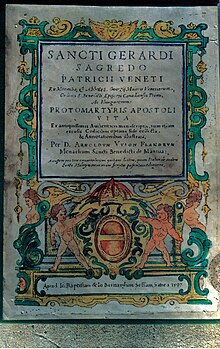Ajtony: Difference between revisions
Remove last map - it was a link to an alternate history site. |
|||
| Line 37: | Line 37: | ||
*[http://www.eliznik.org.uk/RomaniaHistory/trans-gesta_hun.htm ''Gesta Hungarorum''] |
*[http://www.eliznik.org.uk/RomaniaHistory/trans-gesta_hun.htm ''Gesta Hungarorum''] |
||
*[http://www.euratlas.com/big/big1000.htm Map] |
*[http://www.euratlas.com/big/big1000.htm Map] |
||
*[http://www.bethisad.com/map_europe_1000ad.jpg Map] |
|||
[[Category:Banat]] |
[[Category:Banat]] |
||
Revision as of 23:23, 11 December 2008

Ahtum (Bulgarian and Serbian Cyrillic: Ахтум; Hungarian: Ajtony; also spelled Ohtum or Achtum) was an early 11th century voivod (duke) of Banat (now mostly divided between Romania and Serbia) and a descendant of Glad, another local duke and governor in the First Bulgarian Empire. Ahtum was the last local ruler who was opposed to the establishment of the Kingdom of Hungary.
Life
Ahtum was of the Orthodox Christian faith, an ally of the Byzantine Empire and was sustained by an army of Bulgarians and probably Vlachs. He was baptized as an Orthodox Christian in Vidin, but would continue to live as a polygamist with seven wives. The territory where he ruled was located between Mureş, Tisa, and Danube rivers, and the southern Carpathians, in a region that would later be called the Banat.
Various sources mention that Ahtum was a vassal of the Bulgarian Empire, a vassal of the Kingdom of Hungary, and an independent ruler. According to one source, his capital was located near the Mureş River, while another source stated his capital was Vidin. Ahtum also built many churches and monasteries by which he helped spread Christianity in Transylvania.
Duke Ahtum was eventually defeated by the Kingdom of Hungary, at this time under Saint Stephen. The date of his defeat is not clear, some historians suggest 1028, while others around 1002. It is probable that it happened during the war between the Bulgarian Empire and the Kingdom of Hungary, 1002-1003. A Bulgarian army headed by Duke Ahtum was defeated by the Magyars, while Vidin was besieged by Byzantine forces. The Duke perished in the battle. [1] According to the "Gesta Hungarorum," Ahtum was killed by Csanad, the son of Bobuka. After his death, the Banat was included in the Hungarian Kingdom.
Sources

The main historical source about Duke Ahtum is the Legend of Saint Gerard (Sancti Gerardi) and he is also mentioned in the Anonymus' "Gesta Hungarorum." His mention in the Legend has nothing to do with the life of Saint Gerard. The story was probably inserted in order to emphasise a victory of a Latin rite ruler over an Eastern rite one at a time when the Popes were trying to expand their influence into South-Eastern Europe.
The Legend of Saint Gerard discloses that followers of a Bulgarian dualist heresy called Bogomilism were present in Ahtum's realm. They invoked the Archangel Uriel whose name is common in amulets and magic rituals.
Another fact proving the close connections between Ahtum and Bulgaria is the architectural plan of the five-apse church which he built in the Cenad fortress. It closely copies that of a church in Vinitsa near the Old Bulgarian capital of Preslav (893-971).
Literature
- Kristó, G., "Aitony and Vidin", in Turkish-Bulgarian-Hungarian Relations (VI.-XI. c.) (Budapest, 1981) (Studia Turco-Hungarica, 5), pp. 129-135.
- Peter Rokai, Zoltan Đere, Tibor Pal, Aleksandar Kasaš, "Istorija Mađara", Beograd, 2002.
- E. v. Ivánka, "Gerardus Moresanus, der Erzengel Uriel und die Bogomilen", Orientalia Christiana Periodica, XXI, 1-2 (1955) (Miscellanea Georg Hofmann S.J.), S. 143-146.
- S. Móré Heitel, "Despre biserica lui Ahtum de la Morisena (Cenad)", Studii şi materiale de istorie medie, XXIII (2005), pp. 9-21.
Footnotes
- ^ "Венедиков," pp. 151-152.
